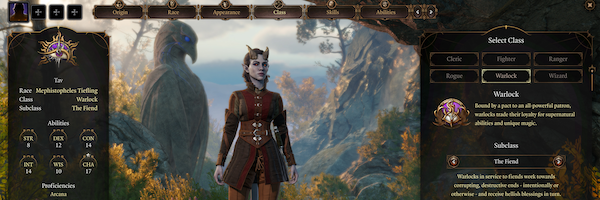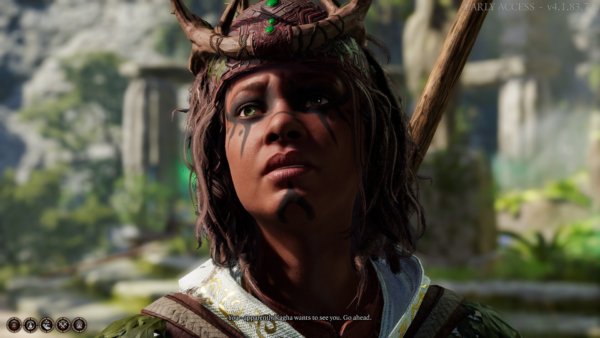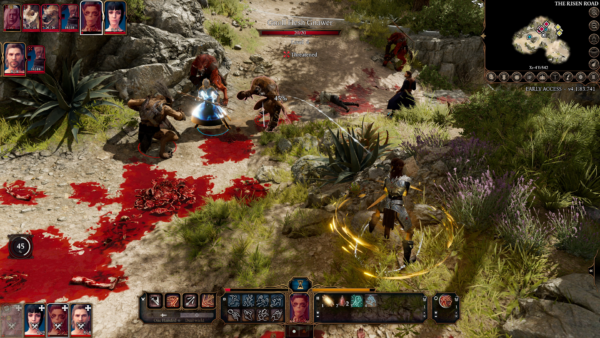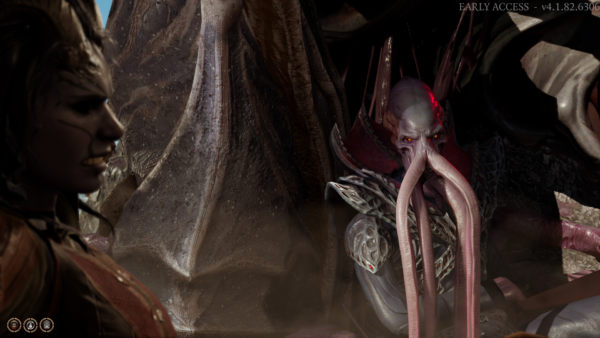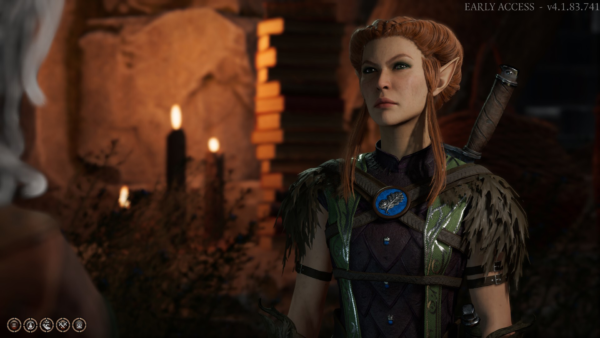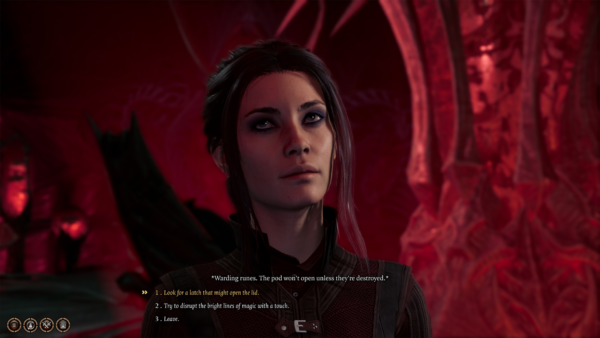Baldur's Gate III, the unexpected sequel to Bioware’s CRPG classic Baldur’s Gate II, was released in Early Access two weeks ago. The game is, understandably, rough around the edges. It crashes often and is pretty buggy in its current state. I’m certainly not going to knock the game for that, or even go into further detail—these are the kinds of things Larian Studios, the game’s developer, is well aware of.
I’m a big fan of RPGs. They’re my favorite type of video game by far. I love getting caught in winding dialogue, evolving my character across a lengthy journey, and, on subsequent replays, exploring previously unexplored venues and finding secrets I may have missed. The promise of an exclusive, unique adventure that you craft yourself is enticing. Baldur’s Gate III promises a lot coming on the heels of Divinity Original Sin II, Larian’s crowning achievement and arguably the best CRPG made to date.
Over the past two weeks, I’ve played through what the game has to offer in its current state once and am working my way through a second run to see how it stacks up.
So how is Baldur’s Gate III? Well, it’s hard to appraise entirely the way it is now. There are things that are noticeably missing that I expect to be filled in as time goes on. Larian has already stated the full game won’t be released until it's been in Early Access for at least a year, and after that, you won’t even be able to import your save from the Early Access version into the final game. That seems to indicate some major changes coming over the coming months.
Larian has already been great about working with player feedback, and seem dedicated to delivering on the game because they know how much the series means for RPG fans. They’ve also proven to have quite the sense of humor about it.
So let’s see what sticks out about Baldur’s Gate III and where Larian has room to improve it. It’s a promising game with a lot of potential, but something to wait on unless you’re really curious or an avid fan.
LARIAN STUDIOS CAN’T SAVE DUNGEONS & DRAGONS FROM SUCKING
I’ve been actively playing tabletop RPGs for three years, and Dungeons & Dragons is easily the worst game I’ve played. It’s meticulous to a fault and difficult to learn, requires half-a-fortune in books, figures, and other materials and has long had a problem with racial essentialism. I didn’t think I would be able to stomach a game based on D&D systems again after being spoiled by wonderful, fiction-focused games like Dungeon World and Blades in the Dark, but Larian Studios gave me hope. This was the developer behind Divinity Original Sin II, one of the most approachable CRPGs ever made.
In Original Sin II, you aren’t confined by your race or even the class you start as. Over time, you are able to diversify your character however you want. Instead of gatekeeping abilities behind arbitrary backgrounds you picked at the start of the game, you’re allowed to learn any of the skills from the game’s 10 schools at any time, provided you level a point in that tree. Upon each level up, you get a point to distribute freely, and only the most exceptional of abilities require more than three in a particular school to use. You’re allowed to experiment and see what works for you, and the game has built up a healthy community dedicated to crafting builds using the game’s limitless options.
Larian Studios couldn’t rescue Baldur’s Gate 3 from Dungeons & Dragons' most tedious and even problematic trappings. Upon starting the game, seeing that there was no Orc option (my typical choice in any high fantasy RPG), I decided to play a Tiefling. I’m informed that Tieflings are often violently ostracized from society and even lack their own culture because of their heritage. Tieflings are the result of humans having offspring with Fiends, which results in a little red devil with black sclera and a pointy tail. This kind of half-hearted portrayal of racism does little to enhance my enjoyment of the game or understanding of Faerun—all it does is signal that mixed-race people are naturally treated with prejudice, or, even worse, are somehow demonic in nature.
Baldur’s Gate 3’s incomplete roster of races further highlights Dungeons & Dragons’ bizarre fascination with mixed-race people. Half-elves are unable to be accepted fully in human or elven society, and half-drow (or dark elves, and we won’t even get started on how elves with darker complexions are the evil ones) are unwanted underground with fellow drow and are seen as dastardly villains by all other races. Why is this brand of mixed-race diaspora necessary in the game? Why would I want to engage with a fantasy world where the same type of racism we see every day in the real world bubbles to the surface again and again, and is never dealt with meaningfully?
COMBAT AND DIALOGUE ARE… WELL, FINE
You won’t find remarkable combat here. In fact, I often found myself trying my best in dialogue to skip combat when possible. It’s tedious and takes a long time, a downgrade from the addictive terrain-based fights in DOSII. It’s another example of D&D’s underpinning limiting Larian from truly stretching their creativity. It’s certainly not the worst I’ve played in a CRPG, but combat feels somewhat dated in a genre that has since evolved.
Dialogue is where the real fun is. Though the writing is occasionally hokey, the way Larian incorporates ability checks is clever and satisfying. In D&D, your DM might ask you to pass an ability check before you’re able to do something you want to do. It might be something like intimidating a crime boss. Doing something like that is pretty hard, so they might set the DC to 15. You then roll a d20 die and, if your roll (supplemented by your modifier, if you’re proficient) is higher than the DC, you’re successful. If you fail, your DM gets to make a move against you. That means it won’t necessarily play out as, “You failed, come back later,” but you’ll have to deal with some consequences for failing.
Failure in tabletop should always be interesting. When I DM, I subconsciously always want the players to succeed, if just because I know how things will play out if I do. Making failure fun requires a little more brain power. Thankfully, Larian is pretty good about making you feel good about screwing up. During my time with the Early Access, I didn’t really find myself save scumming to get a “better” result—I care about the fiction first and foremost in tabletop, so I wanted to ride my choices out and see how they went.
The only problem is the situations you’re put in aren’t always all that interesting, at least not in the game’s current state. We’re only getting a slice of the game’s first act, so it’s understandable that the stakes aren’t too high and the situations aren’t too wacky right now. Hopefully the game takes some notes from Disco Elysium, which uses a similar dice roll system and always, always makes sure the player is engaged with each successful or failed roll with plenty of possibilities.
CHARACTER CREATION AS IT SHOULD BE: SIMPLE WITH DIVERSE OPTIONS
Who doesn’t love a good character creator? Half the fun of RPGs is diversifying your playthrough, and defining who you’re playing as, what their motivations are, and how they fight is your first step towards true immersion. Baldur’s Gate II and even Divinity Original Sin II were pretty light when it came to visual customization of your character, so it's pleasing to see just how much Larian has upgraded even in Early Access.
Instead of getting to meticulously manipulate your character’s cheekbones as in Skyrim or Black Desert Online, Larian claims to have scanned “over 40 people of different ages and ethnicity” for the game. This means that you’ll only be able to pick from a handful of faces for each race, but each one is lifelike in a way that can be hard to capture in a more robust character creator. The game also has a lovely collection of skin tone and hair options. There’s a checkbox that you can tick to see the full range of color options that aren’t necessarily “lore adherent,” so you can go absolutely wild if you want to. You want to be a purple elf with green hair? Go right ahead!
As Ash Parrish pointed out, the game is a victory so far for POC players. Typically POC are underserved in RPGs, which include a narrow range of darker skin tones and half-assed hair textures. Parrish does, however, point out the lack of Asian faces for characters other than elves and tieflings, an odd decision that will hopefully be updated sooner. Not a great look to deny Asian players the ability to play as a human who looks like them.
Most disappointingly, you’re completely unable to alter the body type of your character. This means, no matter what, you’ll be playing as a thin person (unless you’re playing as a dwarf). I don’t consider this an optional addition to the game’s final build. I consider it completely essential. What kind of message are you sending to your players when your cool fantasy adventure party is only populated by underwear models? Even if there’s just a few preset options, I’d like to see some fuller-figured options soon.
Fans of Dungeons & Dragons might be disappointed to find a rather scant selection of available classes, with just half of the total 12 core classes from 5e. Right now, you can pick between cleric, fighter, ranger, rogue, warlock, and wizard. That means at the moment monk, barbarian, paladin, bard, druid, and sorcerer are not represented. Each class will eventually have their own sub-classes, but at the moment, only warlock and cleric will be able to pick a corresponding specialization.
For the D&D uninitiated, the game kindly suggests Starting spells, proficiencies, and stats so you don’t end up speccing yourself into a wall. Your character sheet will probably be very overwhelming if you’ve never played D&D (maybe even if you have) and the game doesn’t exactly explain every detail that might be obvious to more experienced players (What’s the difference between a cantrip and a spell? What’s a saving throw?).
In later builds of the game, you’ll be able to start with preset legacy characters, the likes of which you’ll encounter yourself during the course of the game. They’re the party members you get to pick from. If DOSII is any indication, playing as one of these legacy characters will come with some unique interactions you won’t be able to get when playing with an original character. Personally, I much prefer making my own rather than playing a pre-existing character, but it’s something to look for as the game continues to expand.
I’m more so hoping for more race options. It’d be a crime not to include half-orcs and dragonborn, two of the core races from the 5e Player’s Handbook that are missing, but my pipe dream remains as playable Aarakocra and Yuan-ti. I’m desperately missing the lizards in DOSII.
SOCIETY HAS MOVED PAST THE NEED FOR QUIRKY PARTY MEMBERS
Since the dawn of Dragon Age, the quirky, manic party member has been unavoidable. Don’t get me wrong—I was charmed by the eccentricities of the Dragon Age characters back in the day. What disappoints me is the inability to receive RPG party members that aren’t somehow cheesily sarcastic, dorky and inept, or condescending assholes. And these traits are supposed to endear me to these characters?
Upon meeting Astarion, a high elf dressed like Dracula with wavy silver dreamboat hair, he attacks you from behind with a dagger. After you wrest yourself free you have to go through a whole song and dance to convince him you weren’t one of his captors, after which he gleefully flashes his sharped vampire teeth and apologizes for almost cutting you open. He proceeds to be an incorrigible flirt after this. I love playing these games for the romance options, but I’m supposed to be charmed by this?
At the end of the day, it’s lazy character writing, a cheap fallback to substitute actual substance. If characters are dorky enough, maybe people will turn a blind eye to their lack of sensical motivations, meaningful input, or plot relevance. I’m eagerly looking forward to assembling a team of four for multiplayer—voices I’d rather hear while making my way through the Forgotten Realms.
Right now, the game’s most interesting character is Lae’zel, a Githyanki warrior with a grudge against the Mindflayers who captured her. She’s the companion that will help you through the tutorial, and you quickly learn that the fight against your eldritch prison wardens is a personal one for her. She’s the one who claims to have a cure for the parasite slowly turning you and your companions into Mindflayers. I felt compelled to pay close attention to her dialogue when I found myself breezing through interactions with the rest of the crew.
Baldur's Gate III is understandably rough around the edges, but it's hard to ignore some of the issues with the game's foundation. Still, it's chock full of content even in its early phases and can be tackled with a myriad of playstyles.
Rating: B-

